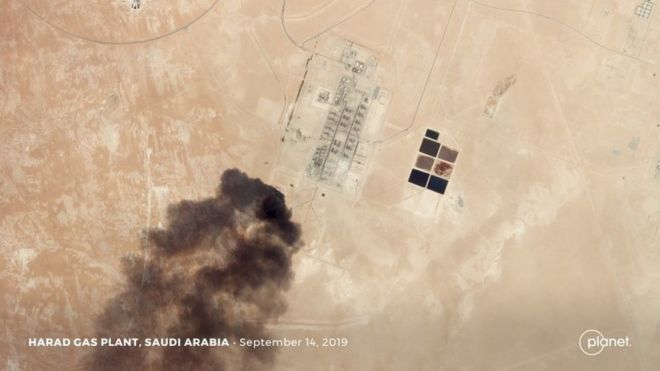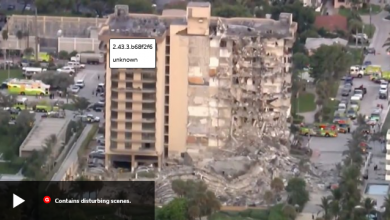International
Saudi oil attacks: US says intelligence shows Iran involved

The United States has issued satellite images and cited intelligence to back its claim that Iran was behind attacks on major Saudi oil facilities.
Iran denies involvement in Saturday’s air attacks, which were claimed by Iran-aligned Houthi rebels in Yemen.
But unnamed US officials speaking to US and international media say the direction and extent of the attacks cast doubt on Houthi involvement.
The incident has cut global oil supplies by 5% and prices have soared.
What is the US saying?
Secretary of State Mike Pompeo blamed Iran at the weekend, without providing any evidence, prompting Tehran to accuse Washington of deceit.
Tweeting on Sunday, President Donald Trump stopped short of directly accusing Iran, but suggested possible military action once the perpetrator was known.
Unnamed US officials have been speaking to the New York Times, ABC and Reuters.
One official said there were 19 points of impact on the targets and the attacks had come from a west-north-west direction – not Houthi-controlled territory in Yemen, which lies to the south-west of the Saudi oil facilities.
The officials said that could suggest launch sites in the northern Gulf, Iran or Iraq.
A close-up image of damaged tanks at the Abqaiq processing plant appeared to show impact points on the western side.
Iraq has denied the attacks were launched from its territory.
Officials quoted by the New York Times said a mix of drones and cruise missiles might have been deployed, but that not all hit their targets at Abqaiq and the Khurais oilfield.
ABC quoted a senior US official as saying that Mr Trump was fully aware that Iran was responsible.
China and the European Union have, separately, urged restraint.
In the UK, Foreign Secretary Dominic Raab said it was not yet clear who was responsible for what he described as a “wanton violation of international law”.
What are the oil markets doing?
The oil price has seen the biggest one-day rise since the 1991 Gulf War, rising 20% but falling back later.
The international benchmark used by traders, Brent crude, jumped to $71.95 a barrel at one point.
Prices eased after President Trump authorised the release of US reserves.
But there are concerns that higher prices could continue if tensions worsen further.
As for consumers, it is too early to tell if they will see an impact, writes BBC Business reporter Katie Prescott. Any rise could take weeks to feed through to petrol prices.
US Energy Secretary Rick Perry, blaming Iran, said on Monday that the oil market was “resilient and will respond positively”.
How has Iran reacted?
Iran has yet to respond to the latest US assertions.
But Iranian Foreign Minister Javad Zarif tweeted on Sunday to deride Mr Pompeo, saying that “having failed at max pressure, Sec Pompeo’s turning to max deceit”.
He was referring to the Trump administration’s stated “maximum pressure campaign” which has targeted Iran with sanctions since Washington pulled out of an international agreement to limit the scope of Iran’s nuclear programme.
How did Saturday’s attacks unfold?
The attacks targeted Abqaiq, the site of the largest oil processing plant run by the Saudi state oil company, Aramco, and the Khurais oilfield.
Khurais is the closest of the targets to the Yemen border – still a considerable 770km (480 miles) away.
Saudi Arabia said drones carried out the attacks, which began at 04:00 local time (01:00 GMT) and sent huge clouds of thick, black smoke into the air.
The Houthi movement said its forces sent 10 drones towards the facilities and have since warned of further attacks.
There were no reports of injuries, but the extent of the damage to the facilities is still not entirely clear.
Why might the Houthis have attacked Saudi Arabia?
The Houthis have repeatedly launched rockets, missiles and drones toward populated areas in Saudi Arabia. The attacks have left at least four civilians dead.
The Yemen conflict escalated in March 2015, when the Houthis seized control of much of the west of the country and forced President Abdrabbuh Mansour Hadi to flee abroad.
Alarmed by the rise of a group they believed to be backed militarily by regional Shia power Iran, Saudi Arabia and eight other mostly Sunni Arab states began an air campaign aimed at restoring Mr Hadi’s government.
The UN says the conflict has claimed the lives of at least 7,290 civilians and left 80% of the population – 24 million people – in need of humanitarian assistance or protection, including 10 million who rely on food aid to survive.
Source: bbc.com


